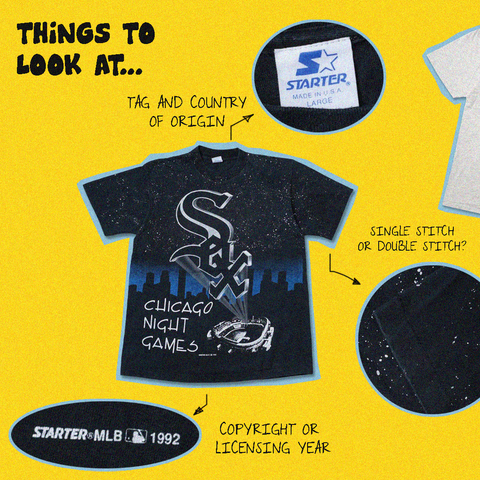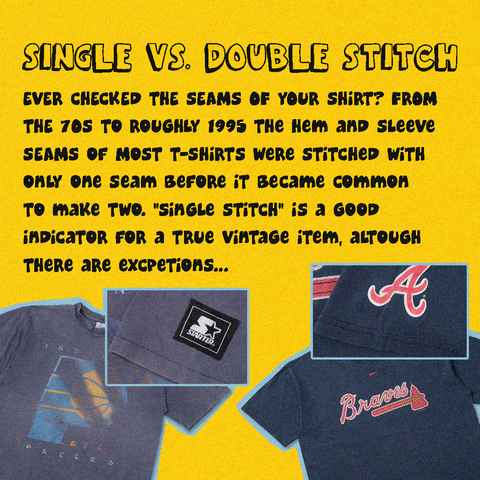
All Things Vintage: How to Date Vintage
You have FINALLY found the band shirt from the 90s, after you have been looking for forever. And at a great price. But... how can you tell if it's really vintage - or just a reprint that counterfeiters are currently flooding the internet with? With the following five tips you can classify it!

1. Copyright
First of all, you can check the T-shirt for a license print: These are often hidden next to the print on graphic shirts. Check here if a year and a "C" [©] are included in the license line. Also look out for spelling mistakes: If, for example, a rare Akira shirt says "Akira Commiffee" instead of "Akira Committee" in the license print, the shirt is guaranteed to be a fake. Counterfeiters often use visually similar words so that when we quickly read them, our brain tricks us into thinking the exact word we suspect or hope to see there.
On vintage pieces without graphics, you can also sometimes find a year or copyright "C" on the label at the neck. Please note: In both cases, the year numbers do not necessarily have to refer to the year the item was made. Items from the trading card game "Yu-Gi-Oh!", for example, are always marked with "1996". However, the year here refers to the year in which Yu-Gi-Oh! first registered a copyright. The more pieces you come across, the more you get a feel for this.
2. Size Tags
"Size Tags" are the size indicators sewn into the neck of tops. Speaking of 'sewn in', if the size tag is printed or flocked on the back of the neck, the top is definitely not vintage - printed sizes have only been around since the 2010s.
But back to real size tags: with those, it's not just a possible copyright or year (usually hidden on the back or another tag) that counts, but also the label itself. Every major company has produced its own size tags, for which there are already some overviews online - the so-called "Size Tag Guides". You can find them via Google Image Search: For example, type in "Adidas Size Tag 90s" and you'll find a legend of when the sporting goods manufacturer used which tag.
What also helps is to look for similar items at trusted online stores: When big sellers like Round Two, For All To Envy or us at Double Double have posted a vintage garment, it has always been checked and verified as genuine vintage. The matching photo of the (authentic) label is always conveniently shown.

3. "Made in..." & Material
When comparing the size tags, you may notice that the production sites of some brands have changed over time: "Made in USA" may have given way to "Made in Mexico" or "Made in China" at some point. Here, over time, you get a sense of which time period a brand produced in which country. Fake vintage shirts often do not pay attention to such details: For example, a "Made in USA" size tag is sewn into every shirt that pretends to be from the early 90s. Here it is also worthwhile to compare the size tags (as described in point 2) exactly.
But: Even with real vintage tags there are exceptions and deviations, because sometimes there were factories in several places at the same time. So just because you've seen a certain sweater with "Made in USA" doesn't mean that it can't also exist with a tag à la "Made in Honduras".
The material composition of vintage pieces is similarly ambivalent, e.g. "100% Cotton". You can often find this info on the Size Tag or the 'Wash Sheet' tag (on the inside of shirts). While T-shirts before the beginning of the 90s were mainly made with "Cotton Blend", i.e. a mixture of cotton and polyester, until today almost only 100% cotton is used for production. The emphasis, however, is on "almost": some manufacturers were still using old shirt blanks with cotton blend for printing at the end of the 1990s (or later). So if a T-shirt is titled "Cotton Blend," that doesn't necessarily mean it was made before the '90s.
4. single stitch vs. double stitch
Another indication of when a T-shirt originated can be the seams. The sleeve ends and the hem of T-shirts were mostly sewn with only one seam from (about) 1970 to (about) 1995: This is called a "single stitch".
If you are wearing a T-shirt from the last 20 years, take a look at the two seams mentioned: In all likelihood, it will have two rows of stitching next to each other. This processing slowly replaced the "single stitch" in the mid-90s. Explanations for this change vary: Some say that two stitches were necessary to compensate for inferior cotton. Others argue that double stitching makes a shirt more durable.
The fact is, "single stitch" can be a good indication of a shirt's age - but it doesn't have to be. Why is that? First, (authentic) T-shirts from the 70s and 80s with two seams exist occasionally. Second, shirts from all decades of the "Single Stitch" sometimes have a seam on the sleeve, but "Double Stitch" on the hem. Or vice versa. And to make things even more complicated, counterfeiters are now producing their old-fashioned shirts with only one seam again: they, too, have realized that they can smuggle a new shirt as vintage using the "single stitch".

The big "but": Context is Key!
As explained above, a close look at the following four points helps: Copyright, Size Tag, the addition of "Made in..." plus material, and the stitching. However, there are exceptions to all of these. For example, with a doublestitched T-shirt it is difficult if all labels have been cut out.
Some shirts have no copyright because they are bootlegs - shirts that someone printed without permission (e.g. Madonna). These bootleg shirts are then not original products, but can still be 'original' from the 80s - in contrast to fake "vintage Madonna" shirts produced today, which neither have the license from Madonna, nor are actually old.

What does one do then? Basically, context is important. This includes where you found a garment: You should always be careful with faceless, anonymous sellers on public online sales platforms. If the price is too good to be true, it's better to ask or leave it be - especially with eBay users with few ratings. It's a different story with the nice old lady at the flea market.
It's also extremely helpful to look deeper into the subject: What was the color aesthetic at the time I'm looking for a piece from? What fonts became popular only after that? Looking through other clothing from the time helps with both questions. In the case of the band shirt mentioned above, it also helps to become well acquainted with the band: Was the alleged "Mid 90s Tupac Shirt" perhaps made using a photo that wasn't released until after his death in 1996? If so, the shirt was produced later. Also, Instagram accounts like @doctorfugazi that give regular updates on new fakes in circulation help.
Of course, it also helps to buy directly from trustworthy vintage stores - we know of one in Mannheim, for example ;)
PS: Do you have any other tips on how to distinguish real vintage from fake? Then feel free to leave us a comment!